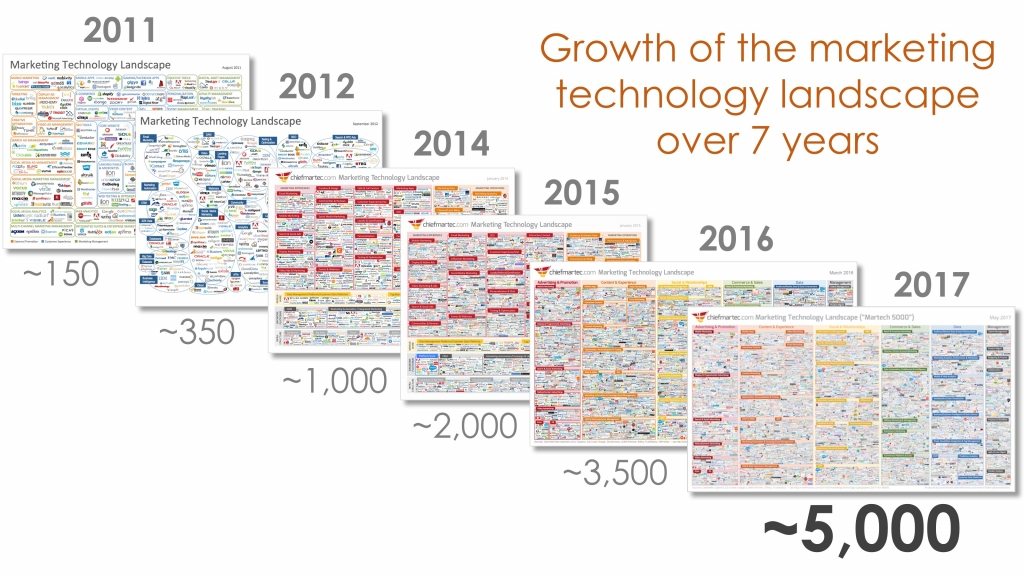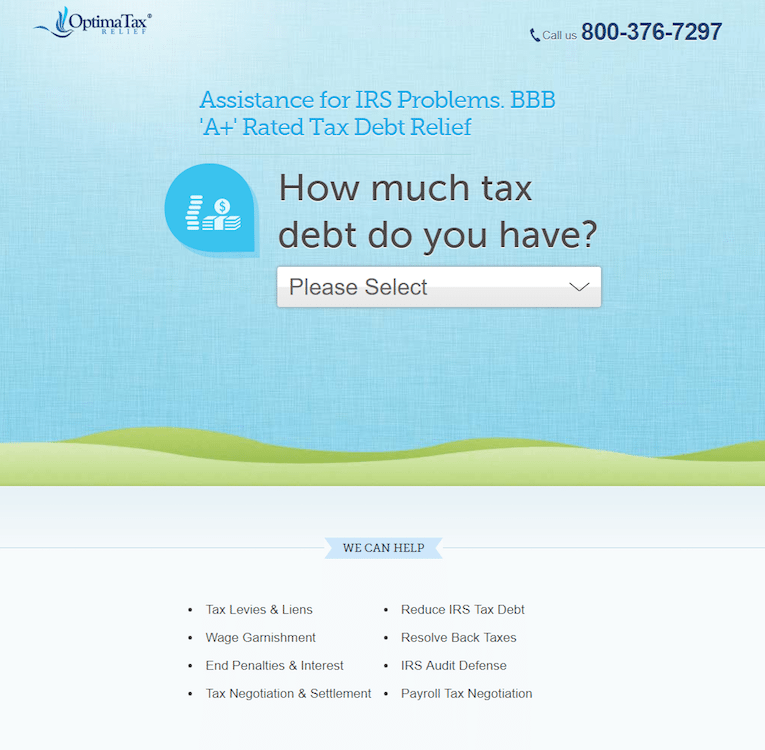To complete your ad stack in 2022, you need to know the best platforms available to you. Yet with the marketing tech landscape expanding faster than ever, selecting the best platforms is no easy task. For example, in 2011, there were only about 150 marketing technologies available to businesses. Today, there are well over 5,000:

With such an abundance of software options to choose from, many organizations believe it’s easiest and most beneficial to use an all-in-one software, rather than multiple dedicated software tools for each marketing discipline. But that isn’t necessarily true.
Dedicated marketing solutions, or best-of-breed software, are unequivocally the better option for large companies and enterprises with the means to purchase a different software for each marketing discipline. So with an advertising budget of over $1M, it’s more advantageous to have a best ad stack that covers each individual area: CRM, email marketing, content management, landing pages, analytics, A/B testing, etc.
In fact, one study found that:
- 82% of marketers use a best-of-breed marketing stack, while only 18% use a single-vendor suite
- 95% of marketers believe a best-of-breed stack provides better monetary value than a single-vendor marketing suite
- 54% of single-vendor suite users don’t believe an all-in-one tool provides value, because it requires too much work from an outside consultant or developer
The main reason to opt for a best-of-breed marketing stack is simple: All-in-one suites aren’t sufficient. By attempting to master all disciplines, single-vendor suites dilute themselves and leave marketers with only partial solutions.
Conversely, purchasing dedicated software allows large companies and enterprises to build powerful marketing stacks, which involves selecting and implementing a leading solution to manage and perform each various task or function.
To make building a best-of-breed ad tech stack easier for businesses with an advertising budget over $1 million, we’ve compiled The Advertising Stack to Power Your $1M+ Ad Spend:
With this new comprehensive resource, you’ll learn:
- Why best-of-breed software is superior to all-in-one technologies
- The 9 software categories that all large businesses and enterprises should have in their advertising stack
- The highest-rated and recommended platforms for each category
- How supply-side and demand-side platforms are integrated with an advertising stack
- Why your ad campaigns can’t forget about landing page optimization to maximize ROI
Let’s take a little closer look at that second bullet point.
9 software categories to complete your digital ad stack
1. Search advertising
90% of B2B consumers start their buying research with a search engine so you need to be where your potential customers already exist.
Search advertising involves serving paid ads to high-intent users of search engines, who are looking specifically for a solution to a problem, like this:

Search advertising software helps advertisers bid on keywords relevant to their business, and serve messages on popular SERPs. It allows advertisers to create, manage, and track ads, where the average cost per click is $2.32.
2. Display advertising
Display advertising refers to the process of advertising a product or service through visuals on web pages affiliated with a display advertising network (like the Google Display Network) both in content and around it, such as in the header, footer, or sidebar.
Here are three display advertisement examples on a single web page — one in the header, one in the right sidebar, and one at the bottom of the screen:

Software in the display advertising category helps brands create ads, manage publishing locations around the web, target the most appropriate prospects, and track the ROI of campaigns. The average display ad costs just under $0.58.
3. Mobile advertising
In 2014, mobile traffic surpassed desktop traffic.
In 2016, the average adult spent two-thirds of their digital media time on mobile.
By 2019, it’s projected that mobile ad spending will represent 72% of all ad spending.
These three revelations make it clear that advertisers need to not only optimize for mobile, but prioritize mobile advertising, which refers to the output of paid marketing messages on all types of mobile devices — cell phones, tablets, etc.
The cost of mobile ads vary based on device, placement, type, etc., but research has shown that on average:
- iOS banners range from $0.20-$2.00
- iOS interstitials range from $3.00-$5.00
- Android banners range from $0.15-$1.50
- Android interstitials range from $2.00-$4.00
Mobile advertising software enables advertisers to buy, place, and manage mobile ads including but not limited to banner ads, interstitial ads, and mobile app ads — all designed to appear in front of users where they’re spending all their time.
4. Social media advertising
Today, more than 80% of people in the US have a social media profile. In fact, the average internet user actually has an account on 7 different social networks. So failing to give your brand a presence on social media where your prospects are spending their time would be missing out on a golden opportunity.
Social media advertising is the process of serving paid messages to social media users on various platforms, like this Facebook in-stream ad:

Although social media ads typically appear in sidebars and natively in users feeds (like the one above), software in this category also allows advertisers to target social media users both on and off the platform.
No matter where the ad is displayed or who it’s targeting, the average cost of social media ads vary by network. For example, with Facebook, the average CPC is approximately $1.72, whereas LinkedIn ads range from $2-$5 per click.
5. Cross-channel advertising
With your prospects on many different devices and platforms, it’s seemingly impossible to be everywhere they are. This is especially true since they don’t stick with just one device or platform, but rather, switch back and forth between desktop and mobile, on multiple social networks, etc.
While getting in front of your prospects everywhere they are may be unrealistic, it’s still important to engage them on as many platforms and devices as possible. That’s because 72% of consumers say they want to interact with a brand on multiple channels. So, not only do you have to serve them ads on every platform and channel, but you have to provide a consistent customer experience as well. This can be accomplished with cross-channel advertising.
Cross-channel advertising involves distributing paid messages across a variety of channels (search, display, social, etc.) to direct prospects to the next stage of your marketing funnel. Software in this category allows advertisers to conveniently consolidate all of their ads for multiple platforms into one place. It also commonly integrates with demand-side tools that enable purchasing, managing, and tracking of placements across all of those platforms.
Cross-channel advertisements appear on at least three networks, such as search engine results pages, display networks, social media platforms, and more.
6. Video advertising
Internet users are obsessed with video. Don’t believe it? Check these stats:
- Between Facebook, YouTube, and Snapchat, there are about 22 billion video views each day
- The average adult watches more online video per week than they do working
- Prospects are 64% more likely to buy a product after watching a video about it
- By 2018, it’s estimated that 80% of all internet traffic will be to video
It has become clear that video is the present and future of marketing.
Video advertising refers to the process of spreading paid marketing messages in video format, such as explainer videos, introductory videos, video testimonials, video case studies, and more. Video ads allow businesses to deliver an interacting and engaging user experience that text and images cannot provide.
This Twitter video ad was created by CrossChx to introduce their artificial intelligence software, Olive, that helps businesses automate workflow across their entire organization:

The video grabs visitors attention and engages them better than just copy or an image would.
Here’s another video ad — a 6-second pre-roll ad on YouTube that is non-skippable, and shown directly before the posted video so viewers are guaranteed to see it:

Video advertising software helps advertisers create, edit, and place branded videos around the internet, located either within content (in-stream video) or outside a web page’s content (outstream video).
The cost to run a video ad depends on many factors like the platform, type of video, length of video, etc. On YouTube, for example, a video view runs between $0.10 and $0.30.
7. Demand-side platforms
Publishers use supply-side platforms to list ad space available on their website. Advertisers then use demand-side platforms to fill that space. This process is known as programmatic advertising.
In 2012, $5 billion worth of advertisements were bought programmatically. Today, 8 out of every 10 ads are bought programmatically. By 2019, that number is expected to jump to $46 billion.
Demand-side platforms allow for the purchase of impressions from marketplaces around the internet that offer ad inventory on publisher websites. Software in this category enables businesses to bid in real-time for the attention of those prospects who are most likely to click through an advertisement and claim an offer on the corresponding landing page.
8. Data management platforms
With the right tracking software you can learn anything you want about your leads and prospects. You can qualify leads by checking their email against a database that will return other personal information like address, company name, home address, etc.
But once you have all that data, how do you make sense of it, manage it, and use it?
That’s what data management platforms are for — storing valuable information about leads and prospects (like cookie IDs), and helping advertisers create segments from that information.
9. Landing page optimization
Many advertisers obsess over creating the perfect advertisement, but in doing so, they forget that the ad itself isn’t what gets people to claim an offer. Rather, it’s the page they land on after they click the ad — the post-ad-click experience — that matters most.
Landing page optimization refers to the process of creating the optimal experience for a prospect after they click an ad, and personalizing it based on a specific audience. Factors like message match, an optimized conversion ratio, and a compelling headline all work together to convince the prospect who just clicked your ad to redeem whatever you’re offering.
Here’s an example of a search ad and corresponding landing page created by Optima Tax Relief that shows each of these necessary components:


These elements can’t be found on a homepage, “About” page, or “Contact” page, though. They can only be found on a post-click landing page, designed with the sole purpose of persuading a visitor to act.
However, it’s not enough to simply create landing pages and direct traffic to them. It’s just as important to optimize and personalize your landing pages based on visitors, with a platform that features components like A/B testing, team collaboration, and heat maps.
View the full advertising stack guide
While choosing a single-vendor suite may seem simpler than finding a best-of-breed software for each individual discipline, the benefits don’t even begin to compare. All-in-one suites tend to be diluted and, therefore, insufficient. There sure to be features you don’t need, and probably some missing capabilities your business can’t function without, too.
For maximum functionality and usability, large businesses and enterprises must build powerful advertising stacks with dedicated software for each unique discipline. Most importantly, they must optimize the landing page with dedicated, personalized landing pages.
View the complete guide today, and get started building your own powerful best-of-breed tech stack complete with the most robust landing page optimization platform available.

